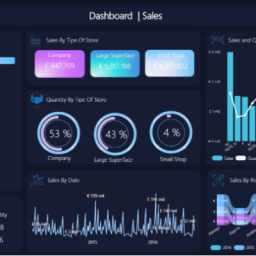
Problem Statement:
The client data landscape encompassed APIs, Excel, Java, SAP, SQL, and more. They required smooth extraction into Azure Data Lake, refinement with Databricks, further processing in Azure, and final integration with Power BI and Business Objects for reporting and dashboard creation. Automation through Azure Data Factory must facilitate seamless migration to SQL.
Solution Overview:
We did the data processing and analysis workflow using various Azure services to create Power BI reports. Here’s a step-by-step explanation of the solution:
The diagram illustrates the data processing and analysis workflow using Azure services to create Power BI reports from both structured and unstructured data sources. Here’s a step-by-step explanation of the solution:
- Ingest Data:
Logs, Files, and Media (Unstructured): Unstructured data such as logs, files, and media is ingested.
Business/Custom Apps (Structured): Structured data from business and custom applications is also ingested.
Azure Data Factory: Both unstructured and structured data are ingested into Azure Data Factory. Azure Data Factory is a cloud-based data integration service that enables the creation of data-driven workflows for orchestrating and automating data movement and data transformation. - Store Data:
Azure Data Lake Storage: The ingested data is then stored in Azure Data Lake Storage. This provides a scalable and secure data lake for high-performance analytics workloads. - Prepare and Train Data:
Databricks: The stored data is processed and transformed using Databricks. It allows for advanced data preparation and transformation using languages like Python, Scala, Spark SQL, and more. - Power BI:
The processed and transformed data is finally visualized and reported in Power BI. Power BI enables users to create interactive and insightful dashboards for better decision-making.
Tech Stack Leveraged:
Azure Data Factory, Azure Data Lake Storage, Databricks, Power BI, Business Objects, and SQL.
Benefits Delivered:
• The solution effectively integrates both structured and unstructured data from diverse sources such as APIs, Excel, Java, SAP, and SQL, ensuring a comprehensive and centralized data repository in Azure Data Lake. This unified approach simplifies data management and provides a single source of truth for analytics.
• With Azure Data Factory automating the extraction, transformation, and loading (ETL) processes, the solution minimizes manual intervention, enhancing operational efficiency. The scalable nature of Azure Data Lake Storage and Databricks ensures that the system can handle growing data volumes and complex transformations seamlessly.
• By leveraging Databricks for data processing and transformation, the solution enables sophisticated data preparation, supporting advanced analytics. The integration with Power BI allows the client to create interactive dashboards, providing actionable insights and improving decision-making across the organization.





